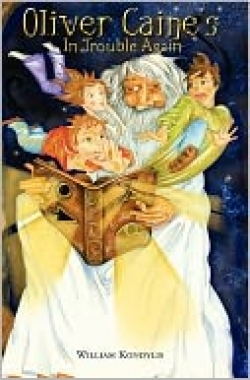
Oliver Caine's in Trouble Again
Tasmania is the setting for Oliver Caine’s in Trouble Again, where the titular character, his sister, and his best friend go for an adventure in an abandoned building scheduled for demolition—they discover more adventure than they ever dreamed.
Oliver Caine has just turned twelve and is itching to see his first teenage birthday—time is a snail to the adolescent. He is inquisitive and a little reckless, and the boring town life he leads causes him to daydream of exciting travels. Peter Higgins is just the opposite. Oliver’s best friend is coddled by a nervous mother and eats when he’s stressed. Sarah, Oliver’s older sister by a few years, pretends he always annoys her, though she’s never really mean to him regardless of the practical jokes he plays.
Oliver and Peter learn that the long-empty estate they’ve christened “Stone Ridge” is slated to be torn down soon. Neither of them have been inside, though they’ve made up plenty of stories about what its interior might contain. They concoct a plan to sneak into the building and spend a night there, but Sarah finds out and threatens to tell unless they take her along. Reluctantly, the boys agree. Once inside the old house, they do some exploring and light a fire in the main fireplace with books and broken furniture. A book is discovered, opened, and like Alice in the rabbit hole in Lewis Carroll’s famed tale, the three children are drawn into another world that has parallels to their own. A quest is thrust upon them, one which will impact their own world regardless of its outcome. Oliver is its focus, and the challenge for all three children is to find their inner strength and become what destiny has given them the chance to be.
Kondylis uses short chapters and a fast pace to support this adventure story, while borrowing elements of several famous fantasy tales such as The Lord of the Rings, The Chronicles of Narnia, Lloyd Alexander’s Welsh Legends series and Harry Potter. He never falls into the stereotypical use of fantasy clichés, a welcome change from the book clones of Tolkien and C. S. Lewis. The closest Kondylis gets to creating elfish creatures is inhabiting the world with pixies. Pegasus makes an appearance, along with sorcerers, a were-panther, and other animals that are more often from the natural world than the supernatural.
The supporting characters are not quite three-dimensional ones, and there’s more telling than showing in many areas. But these flaws are mostly overcome by the solidity of Oliver, Sarah, and Peter as well as the story itself. Even when the quest is complete, there is more to be done, and Kondylis depicts it with humor and kindness.
Young readers who prefer fantasy with a contemporary feel should enjoy this book a great deal. It deserves a place on library shelves as an example of what can be done when traditional fantasy elements aren’t used as crutches for a weak imagination.
Reviewed by
J. G. Stinson
Disclosure: This article is not an endorsement, but a review. The publisher of this book provided free copies of the book and paid a small fee to have their book reviewed by a professional reviewer. Foreword Reviews and Clarion Reviews make no guarantee that the publisher will receive a positive review. Foreword Magazine, Inc. is disclosing this in accordance with the Federal Trade Commission’s 16 CFR, Part 255.
